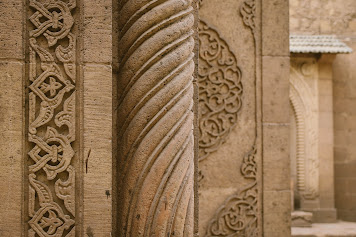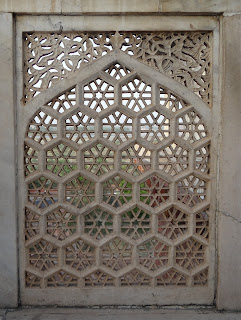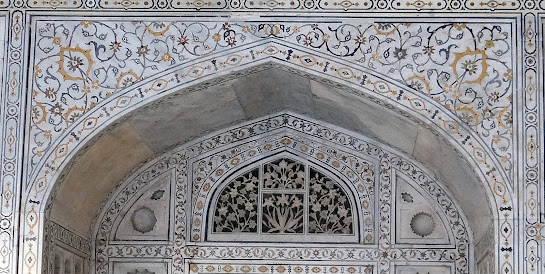There are different kinds of Woodwork Techniques which are applied in Islamic Arts and Architecture in different periods.
Carving :
Carving is one of the most used Woodwork Techniques in Islamic Architecture. In the method of carving, a pointed chisel works out decoration in raised form by carving the surface of the wood. Because of the Perishability of wood, it is more often found as an embellishment inside the building.
Interior wood carvings of the Islamic monuments fall into three categories: Structural element, partitions, and fixtures. The first includes such integral parts of the structure as ceilings, beams, and wall or ceiling brackets. Partitions as a category of architectural woodworking include all those wooden additions which were used to cover openings, to screen areas, or to divide interior space, The most important category for the use of wood carving in Islamic Buildings includes such permanently fixed installations as minbar or pulpit from which the imam delivers his Khutbah during the Friday congregational prayer.
Latticework :
Latticework is one of the woodwork Techniques. It is a piece of material made by crossing lathes over and under each other to create a grid-like pattern. Traditionally, latticework is made of wood but it can also be made with plastic, iron, plaster, and other materials. The lattice is used in many cultures for a variety of decorative and functional purposes.
One common use of latticework is on the privacy screen. The openings in the lattice allow light and air through, less sensitive to climatic conditions where tables are allowed to allow light and air to pass through, which would be worse in a climate where a completely fenced area could be blocked. The lathes network prevents people from seeing inside the letter, allowing for privacy in the area surrounded by lattice activity. Latticework work can be seen in the surrounding buildings and yards, and it is used for things like the installation of windows so that people can enjoy the cool air while still feeling private.
Inlaying :
In this method of the Woodwork Techniques, which is divided as inlaying of the mother of pearl and inlying of wood, the decorative design is drawn on the finished surface by a pointed pencil and the proper places of the design are engraved and then inlaid with mother of pearl, tortoiseshell or ivory. In another kind named ''Damascus work '', the pieces of mother of pearl are surrounded by thin metalwork.
Woodworks in Early Islamic Architecture:
Various woodworks unearthed in the central Asian tumuli and Pazyrk excavations have revealed that Turks were interested in this subject since ancient times. In Islamic art and especially in Omayyad and Abbasid wood works, we find a tendency to look for a new style. The Syrian and Egyptian stone reliefs of the 10th to 13th centuries had influenced the Fatimid woodworks and decorations of acanthus and vine leaves peculiar to the Syrian region were widely used. For example, the stone reliefs on the front of Meshatta palace was revived with nuances in the Omayyad and Abbasid works, was a favorite decoration of this period. The most famous example of Omaayd woodwork is the multi-pieced pulpit of the Qayrawan Mosque made in the 11th century and presently kept in the Cairo museum, and the woodworks in the El hakim mosque reveal the most interesting example of Islamic woodworks.
The magnificent gate displayed in the metropolitan museum and the woodworks displayed in the Cairo Museum, prove that the Fatimid decorations were oriented toward animal motifs in later periods. These decorations are thought to be relative to native art, including hunting scenes, symmetrical groups of birds of animals. this style later influenced the mamluk art and decoration with enriched with all over design. very few examples of Persia woodwork proceeding the Seljuk period have survived until the present day. some wood inscribed with Kufic writing is found in Tashkent and Samarkand Museums and in private collections. Mongolian woodworks of the 13th century are also very rare. wooden door with Kufic inscription show grat similarities with stone decorations in the architecture of the period.
The Seljuk woodworks :
Seljuk considered woodworks very important and they have produced many works of art as pulpits, reading desks, chests of drawers in addition to architectural elements ornamenting buildings. Geometrical forms and plant motifs were often used in Seljuk woodworks where carving and latticework were widely applied. The ornaments were often raised and the compositions were completed with Roman-style borders. The motifs of peacocks, king Solomons seal, and cypress trees were largely used in Seljuk woodworks in Anatolia. The Seljuk woodworks reveal itself on the wooden sarcophagi. The coffin over Mevlana's grave in the Konya Mevlana Tomb is decorated with embellishments characteristics of the age and is covered all over with lyrics poems and couplets.
The Ottoman's woodworks :
The Seljuk woodworks influenced the early ottoman wood works of the 14th and 15th centuries and various works were started to be made by new techniques and with new decorative elements. Besides carving and lattice-work, the dovetail method was widely used and enriched woodworks were made also with the addition of auxiliary elements such as mother of pearls, tortoise shells, and ivory. Floral motifs were often used in addition to Rumi compositions. Beginning with the 16th century, the Rumi decoration on the woodworks gained a much more complex appearance by uniting with the different floral patterns found in the similarly decorated tiles. Although the forms used in the 16th-century woodworks were continued during the 17th century, new patterns were decorated in decorations.
The most renowned of these are the floral motifs that have lost their original forms in a tendency of stylization. Plainness was gradually left and a richer embellishment replaced it.
The Turkish woodworks have influenced architecture, presenting fine examples in old Turkish houses as well as the wooden Afyon Grand Mosque, Sirvirhsar Grand mosque, Beysehir Esrefoglu Mosque. Especially the ceilings of rooms, the shelved niches, and cupboard doors have been fastidiously worked.
stay tuned for more informative blogs. Thank you!







Great info
ReplyDeleteWoooow ❤️❤️❤️❤️
ReplyDelete👍🏻
ReplyDelete